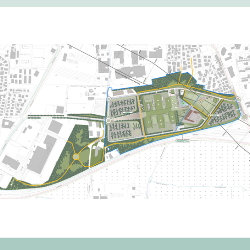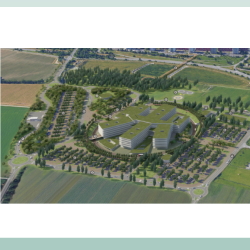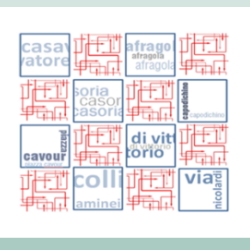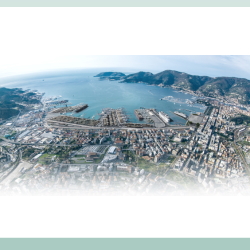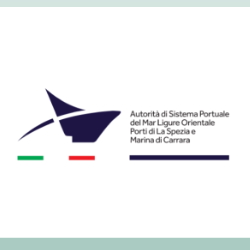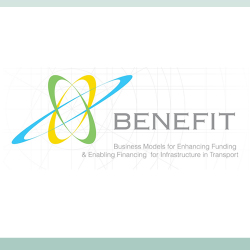Project assessment covers transport infrastructure and beyond
- New hospital in piacenza: transport study and cost-benefit analysis for the design of the feasibility study for the new location in area 5 TRT Trasporti e Territorio was commissioned by the Local Health Unit (AUSL) of Piacenza to provide technical support to the design group led by Policreo Srl, with the in-depth studies on the Transport Study and the Cost-Benefit Analysis developed within the Feasibility Study, (drawn up in accordance with art. 14 of Presidential Decree No. 207/2010), of the New Hospital of Piacenza related to area 5 (AL 9), located in the urban sector within the urban ring road, between Corso Europa and Strada Farnesiana. The study is divided into three main activities: the first is about the mobility and parking system related to the current hospital location, analysing in detail the system of roads, parking and public-private accessibility of the area. the second is about the functionality of the road infrastructures serving the new hospital in Piacenza, assessing the impact of the private mobility system, in terms of road infrastructures and the parking system; the third explores cost-benefit analysis issues, comparing the new project of the hospital with the option of maintaining and upgrading the existing hospital. The cost-benefit analysis estimates the project’s contribution to improving the social-economic well-being of the community, i.e. it estimates whether the social-economic advantages, or benefits, outweigh the disadvantages, or social costs. Related projects: Transport study and cost-benefit analysis of the new hospital in Piacenza [tw_button icon=”” link=”http://www.trt.it/en/projects/” size=”small” rounded=”false” style=”flat” hover=”default” color=”#223468″ target=”_self”]Projects[/tw_button]
- Professional support on the cost-benefit analysis of the «S.S.51 – Variante di Cortina» project A new bypass in the city of Cortina d’Ampezzo (Belluno) is foreseen as part of the infrastructural improvements promoted by Anas S.p.A. in the Veneto region, Italy, and particularly in the areas hosting the XXV Winter Olympic Games in 2026. The project consists of a road bypass alternative to the current route formed by state roads no. 51 «di Alemagna» and no. 48 «delle Dolomiti», which currently pass through the city centre. It aims at lightening the traffic flow crossing the city by moving it towards a different journey – mostly in a tunnel -, thus improving traffic smoothness and the liveability and attractiveness of the popular mountain resort, which enjoys a rich and vibrant tourist market in both winter and summer. TRT developed the cost-benefit analysis of the proposed project according to the most recent guidelines of the Italian Ministry of Infrastructure and Transport. Transport and socio-economic benefits – such as time savings of passengers and goods, as well as a reduction in accident costs – were identified and quantified in monetary terms, and confronted with construction and periodic maintenance costs. Based on results obtained from the economic model, properly discounted over time, the usual indicators for socio-economic returns were computed, i.e., the Economic Net Present Value (NPV), the Internal Rate of Return (IRR), and the benefits-costs ratio (B/C). A sensitivity analysis related to the most critical variables was run, along with the computation of the IRR’s switch values (i.e., the values of individual variables that alone turn the NPV to the negative side). Finally, aiming at valuing the safeguarding of a landscape and touristic asset such as the Italian Dolomites, the analysis was accompanied by a qualitative assessment of the project’s non directly monetizable benefits. These include a higher usability and accessibility of the city centre as a consequence of lower congestion, higher transit speed for extra-urban traffic in case of adverse weather conditions, as well as an increase in road safety thanks to a route running mostly in a double-barrel tunnel. [tw_button icon=”” link=”http://www.trt.it/en/projects/” size=”small” rounded=”false” style=”flat” hover=”default” color=”#223468″ target=”_self”]Projects[/tw_button]
- New Hospital of Piacenza: Contributed to the feasibility study through an in-depth transport system analysis and a Cost-Benefit Analysis TRT Trasporti e Territorio was commissioned by the Local Health Unit of Piacenza to provide technical support for the project of the New Hospital of Piacenza, as part of a consortium led by Policreo Srl. TRT contributed to the feasibility study through an in-depth transport system analysis and a Cost-Benefit Analysis. The activities were divided into three main topics: the first topic concerned the mobility system of the current hospital complex, analysing in detail the road system, the public and private accessibility of the area and the hospital parking area; the second theme assessed the functionality of the road and parking infrastructures serving the new hospital area and estimated the impacts on the private mobility system. The transport analyses concerned the private and public modes as well as cycling and the parking systems. The analysis was conducted through the application of a sophisticated and dynamic traffic micro-simulation tool that provided a series of quantitative parameters (average speed, delays, etc..) functional to assess vehicular flows; The third one was related to the cost-benefit analysis. The analysis was developed comparing the scenario with the new hospital with the scenario where the existing hospital is upgraded/renovated. The cost-benefit analysis estimated the project’s contribution to social welfare, comparing the socio-economic costs of the two scenarios (investment, maintenance, etc.) with the corresponding benefits (health benefits, improved transport accessibility, availability of recreational and green spaces).
- Financial and economic analysis of the new metro line Afragola AV-Napoli and of a moving walkways at Colli Aminei station The project consists of an evaluation of two transport infrastructure projects: the new metro line Afragola-Napoli (LAN) and of a moving walkways at the Colli Aminei metro station (CAM). Respectively, these projects have been planned by the regional administration to connect the Afragola high-speed rail station with Naples inner city, and to improve the accessibility of the (sloping) Colli Aminei metro station. Based on a detailed traffic analysis, TRT carried out a financial and economic evaluation (cost benefit analysis) of the projects, considering on the one hand the project investment and operating costs, and on the other hand the impacts expected from the induced modal shift (lower road traffic levels, travel time savings, reduction of traffic externalities, etc.). The evaluation took into consideration different project layouts of LAN and CAM, contributing to identify the best alternative from a cost-benefit point of view. As provided by the national guidelines on transport project evaluation, a risk analysis was also developed including a qualitative risk analysis, a quantitative risk analysis, a sensitivity analysis. [tw_button icon=”” link=”http://www.trt.it/en/projects/” size=”small” rounded=”false” style=”flat” hover=”default” color=”#223468″ target=”_self”]Projects[/tw_button]
- Financial and economic evaluation of the shore-side electrification project (cold ironing) in the new cruise terminal in La Spezia By electrifying ships hoteling activities, the La Spezia port authority aims to prevent diesel combustion from berthing vessels and avoid exhaust emissions and noise in the port areas. The objective of this project is thus to assess the welfare implications of the shore-side electrification project (cold ironing) and evaluate the feasibility of such infrastructure investment from a socio-economic point of view. Following a cost-benefit analysis approach and based on first-hand information on port traffic flows and infrastructure costs, the analysis estimates the evolution over time of both health benefits and investment and operation costs, providing a monetary quantification of the net social benefits obtained from the electrification of the cruise terminal. Taking into account relevant developments in the maritime and energy sector, such as the diffusion of natural LNG-fuelled cruise vessels and of renewables in the national energy mix, the evaluation work also provides a comprehensive assessment of the convenience of maritime transport electrification as compared to alternative policy options, and a sound case study about more sustainable approach to coastal policy and infrastructure spending.
- La Spezia – Studio trasportistico del “Nuovo molo Crociere nel primo bacino della Spezia” The mobility analysis of the interventions related to the “New cruise pier in the first basin of La Spezia” drafted by TRT was part of the environmental compatibility verification phase of the Project as “functional technical adaptation” of the PRP of La Spezia port and had the following objectives : evaluate any restrictions or opportunities in the sectorial plans and programs in order to verify the consistency of the proposed interventions or specific problems; estimate the land side traffic produced by the current maritime traffic and expected at two future reference years (2025 and 2035); evaluate the impact in terms of the ratio of traffic to capacity, both at local and at regional level. The planning framework was also verified, in relation to the proposed interventions location, the planning tools as well as the traffic forecasts of the cruise pier contained in the previous study developed by TRT through an adjustment of traffic forecasts both sea side and land side. Finally, the traffic impact analysis was carried out. [tw_button icon=”” link=”https://www.trt.it/archivio-progetti/” size=”small” rounded=”false” style=”flat” hover=”default” color=”#223468″ target=”_self”]Projects[/tw_button]
- BENEFIT – Business Models for Enhancing Funding and Enabling Financing of Infrastructure In Transport BENEFIT developed an innovative approach by analysing funding schemes within an inter-related system and depending on their Business Model (described by a governance model). These were key elements in the transport infrastructure provision, operation and maintenance and the funding and financing schemes were analysed in this respect. This envisaging the transferability of findings with respect to the lessons learned, the limitations and the impact of the financial and economic crisis. The BENEFIT project took stock of over twenty years of EC’s funded, national and international research and received direct inputs from the OMEGA Centre and COST Action TU1001. BENEFIT undertook an ex-ante analysis and assessment of transport investments and related funding schemes, including innovative procurements. The BENEFIT project looked at infrastructure project delivery performance. Among various infrastructure project outcomes, it focused on four which are at the heart of the analysis of all major project stakeholders and which influence either directly or indirectly all other anticipated outcomes when a specific project is considered for financing (public or other): cost and time to (construction) completion and actual versus forecast traffic and revenues. The BENEFIT project investigated and researched the conditions and factors leading to the achievement of the above four outcomes distinctively from one another and remained stakeholder neutral, as it did not assume the perspective of any project participant. A key conclusion of the BENEFIT project was that transport infrastructure projects performance is rather independent from the financing scheme, as the conditions of improved performance were mostly related to the actual project characteristics and the competences of the involved parties, including in all cases the competence of the public contracting authority and the level of sharing of responsibility (risks) among the involved parties, also based on their ability to manage them. While, the implementation context (i.e., macro-economic conditions, country competitiveness, supporting institutions) was beyond the control of project decision-makers (i.e., exogenous to the project), and might have significantly influenced the project performance, there were other actionable factors (i.e., endogenous to the project) that might have been influenced by them. Each transport infrastructure mode was influenced differently by its implementation context and different combination of factors contributed in each case to achieving the respective target outcomes. The difference was primarily in the ability to fully endorse factors identified to support the achievement of the project outcomes. On the basis of selected indicators and synthesis of findings, the BENEFIT project developed a rating system describing the likelihood of a project to achieve at a certain point of its life cycle the expected targets (i.e., cost and time to (construction) completion and actual versus forecast traffic and revenues). Within the activities of the study, TRT led the research of the consortium to identify lessons learned. [tw_button icon=”” link=”http://www.trt.it/en/projects/” size=”small” rounded=”false” style=”flat” hover=”default” color=”#223468″ target=”_self”]Projects[/tw_button]

